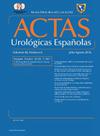机器人根治性前列腺切除术前盆底指导锻炼对尿失禁和生活质量的有效性
IF 1.2
4区 医学
Q3 UROLOGY & NEPHROLOGY
引用次数: 0
摘要
前言与目的前列腺根治术对尿失禁有很大的影响,尽管这是一个多因素的方面。该研究的目的是评估引导盆底运动(PFE)与机器人根治性前列腺切除术(RRP)前书面信息对尿失禁率的影响,以及它们对患者生活质量的影响。材料与方法将62例患者随机分为实验组(物理治疗师指导的练习)和对照组(书面信息)。主要观察指标为尿失禁率(尿垫试验测定)。次要结果为尿失禁严重程度、生活质量(通过36项简短问卷调查工具(SF-36)和国王健康问卷(KHQ)测量)、排尿动态、尿失禁与生活质量的相关性以及其他与尿失禁相关的因素。结果随访1个月内,两组患者尿失禁率差异无统计学意义(82.61% vs 84.62%,第1个月;61.54% vs 75.86%,第3个月;50% vs 53.33%,第6个月;30.77% vs 40%,第12个月),组间尿失禁的严重程度也不相同。与“情绪问题”和“人际关系”相关的生活质量有显著差异,有利于对照组。我们发现尿失禁严重程度与年龄、严重程度与生活质量、急迫性/频率与生活质量之间存在相关性。结论:在失禁率和严重程度上,RRP前的指导练习似乎没有书面信息提供的好处。尿失禁与年龄和生活质量有关。生活质量与尿急和尿频相关。本文章由计算机程序翻译,如有差异,请以英文原文为准。
Eficacia de los ejercicios de suelo pélvico guiados pre-prostatectomía radical robótica en la incontinencia urinaria y calidad de vida
Introduction and objective
Radical prostatectomy has a great impact on urinary continence, although it is a multifactorial aspect. The aim of the study was to evaluate the effect of guided Pelvic Floor Exercises (PFE) versus written information prior to robotic radical prostatectomy (RRP) on the rate of urinary incontinence, and their effect on patients’ quality of life.
Material and method
62 patients were randomized to an experimental (physiotherapist-guided exercises) or control (written information) group. The primary outcome was incontinence rate (measured by pad test). Secondary outcomes were incontinence severity, quality of life (measured by the 36-Item Short Form Survey Instrument (SF-36) and the King's Health Questionnaire (KHQ)), voiding dynamics, correlation between incontinence and quality of life, and other incontinence-related factors.
Results
We found no differences in the incontinence rate between groups in the months of follow-up (82.61% vs 84.62%, month 1; 61.54% vs 75.86%, month 3; 50% vs 53.33%, month 6; 30.77% vs 40%, month 12) nor in the severity of incontinence between groups. There were significant differences in the quality of life related to “emotional problems” and “personal relationships”, in favor of the control group. We found correlations between incontinence severity and age, severity and quality of life, urgency/frequency and quality of life.
Conclusions
Guided exercises prior to RRP do not seem to offer benefits over written information in either the rate or severity of incontinence. Urinary incontinence correlates with age and quality of life. Quality of life correlates with urgency and voiding frequency.
求助全文
通过发布文献求助,成功后即可免费获取论文全文。
去求助
来源期刊

Actas urologicas espanolas
UROLOGY & NEPHROLOGY-
CiteScore
1.90
自引率
0.00%
发文量
98
审稿时长
46 days
期刊介绍:
Actas Urológicas Españolas is an international journal dedicated to urological diseases and renal transplant. It has been the official publication of the Spanish Urology Association since 1974 and of the American Urology Confederation since 2008. Its articles cover all aspects related to urology.
Actas Urológicas Españolas, governed by the peer review system (double blinded), is published online in Spanish and English. Consequently, manuscripts may be sent in Spanish or English and bidirectional free cost translation will be provided.
 求助内容:
求助内容: 应助结果提醒方式:
应助结果提醒方式:


